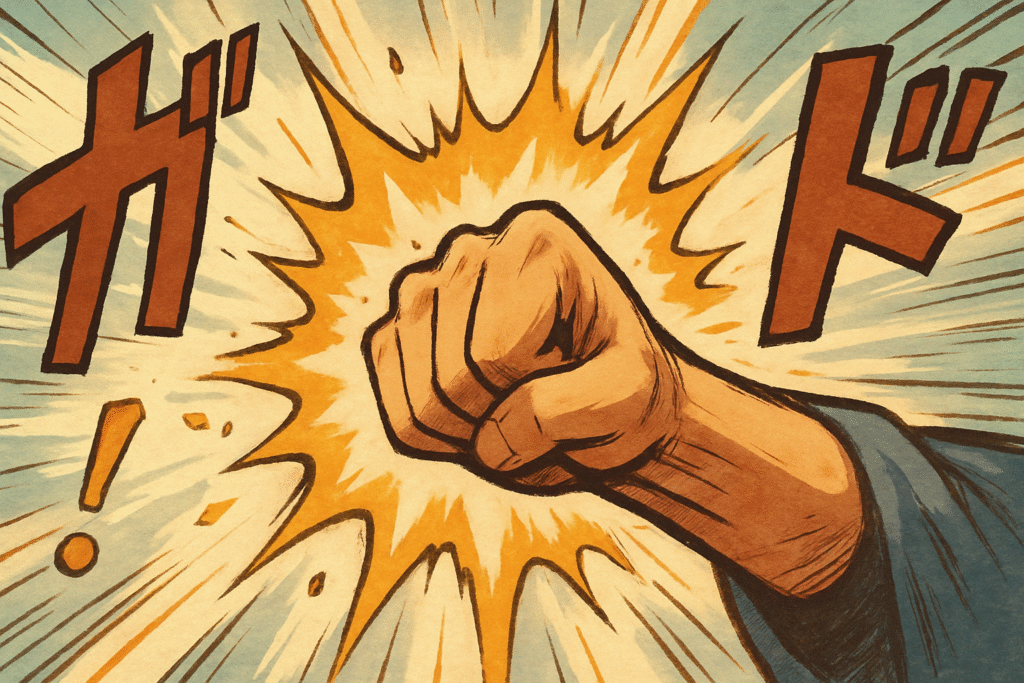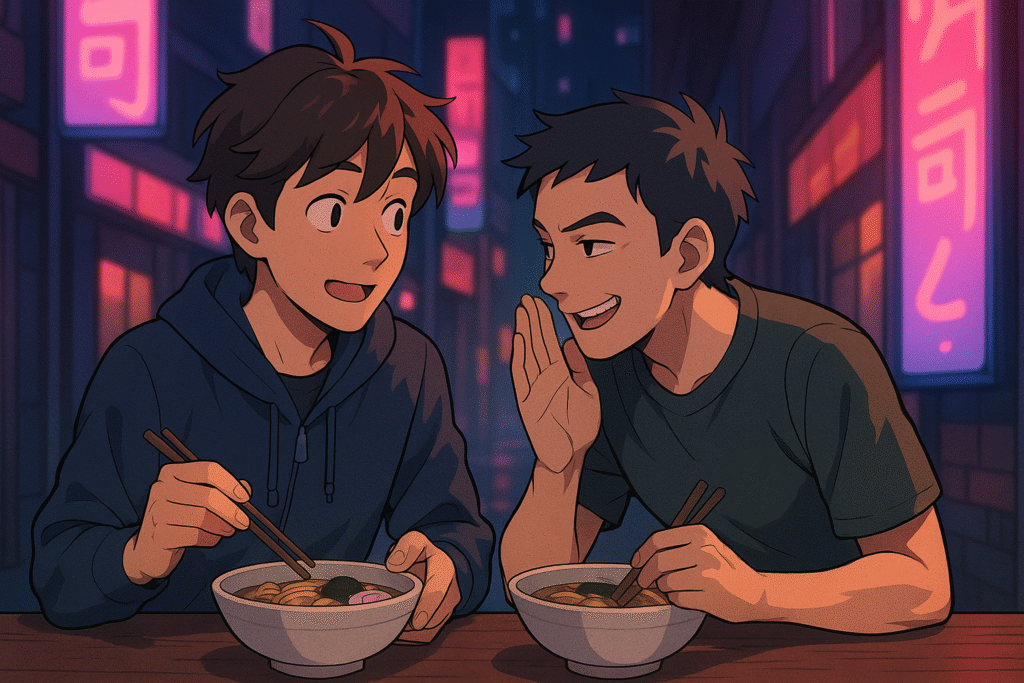Have you ever flipped through a manga and wondered what those stylized Japanese characters scattered across action scenes actually mean? Those dynamic, artistic expressions are manga sound effects—a fascinating aspect of Japanese visual storytelling that adds depth and immersion to every panel. Japanese manga uses an incredibly rich vocabulary of onomatopoeia that goes far beyond the simple “BAM!” and “POW!” found in Western comics. Let’s dive into this colorful world of manga sound effects and discover how they enhance the reading experience!
What Makes Manga Sound Effects Special?
Japanese has approximately 1,200 onomatopoeic expressions—about three times more than English! This rich sound vocabulary allows manga artists to represent everything from emotional states to subtle environmental sounds with precision and artistry.
Unlike Western comics where sound effects are often limited to loud actions, manga sound effects (or “manga SFX”) cover an incredibly wide range:
- Physical sounds (crashes, footsteps, heartbeats)
- Environmental noises (rain, wind, rustling leaves)
- Emotional states (nervousness, happiness, tension)
- Silence (yes, even silence has a sound effect in manga!)
What’s particularly unique is that manga sound effects aren’t just about representing actual sounds—they often express feelings, moods, or visual phenomena that don’t actually make noise.
The Three Families of Japanese Onomatopoeia in Manga
Japanese onomatopoeia found in manga fall into three main categories:
1. Giseigo (擬声語): Mimicking Voices
These represent sounds made by living beings, both human and animal:
- ワンワン (wan-wan): A dog barking (equivalent to “woof-woof”)
- にゃあ (nyaa): A cat meowing
- キャア (kyaa): A scream of surprise or fear
2. Giongo (擬音語): Imitating Sounds
These represent inanimate or natural sounds:
- ザーザー (zaa-zaa): Heavy rainfall (English lacks a direct equivalent!)
- ドン (don): A loud impact or explosion
- カチカチ (kachi-kachi): Clicking sounds, like typing
3. Gitaigo (擬態語): Expressing Conditions
These represent states, feelings, or movements that don’t actually make sounds:
- ニコニコ (niko-niko): Smiling happily
- ドキドキ (doki-doki): Heartbeat/nervousness
- キラキラ (kira-kira): Sparkling or glittering
In my previous article on how to say cute in Japanese, I discussed how the Japanese language has rich expressions for visual concepts—manga sound effects take this characteristic to another level!
Want to explore Japan’s culture?
Discover Japan’s rich culture, traditions, and hidden gems with our expertly crafted guides. Get insider tips on travel, food, and history. All for free!
Why Manga Sound Effects Often Remain Untranslated
You’ve probably noticed that even in English translations of manga, many sound effects remain in their original Japanese. There are several good reasons for this:
- Artistic integration: Sound effects are often beautifully integrated into the artwork
- Cultural authenticity: They preserve the Japanese aesthetic feel
- Translation challenges: Many Japanese onomatopoeia simply don’t have English equivalents
- Production costs: Redrawing all sound effects would be prohibitively expensive
This preservation of original sound effects actually creates a unique learning opportunity for manga readers, who gradually absorb Japanese onomatopoeia through context and repetition.
Popular Manga Sound Effects You Should Know
Let’s explore some common manga sound effects you’ll encounter repeatedly:
Action Sound Effects
- ドドド (do-do-do): Running footsteps
- バキッ (baki): Something breaking or a powerful impact
- ズシン (zushin): A heavy thud
- ガシャン (gashan): Glass breaking
Emotional Sound Effects
- ドキドキ (doki-doki): Heartbeat/nervousness
- ゴゴゴ (go-go-go): Intimidating aura/tension
- モヤモヤ (moya-moya): Feeling confused or unsettled
- ニヤニヤ (niya-niya): Grinning mischievously
Environmental Sound Effects
- ザーザー (zaa-zaa): Heavy rain
- ヒュー (hyuu): Wind blowing
- パラパラ (para-para): Light rainfall
- ジー (jii): The sound of cicadas or electrical buzzing
As I explored in my article about Japanese onomatopoeia examples, these sound effects create a multi-sensory reading experience that purely textual descriptions can’t match.
How to Read Manga Sound Effects
Most manga sound effects are written in katakana (the angular Japanese syllabary), which makes them stand out visually from regular dialogue. Here’s how to approach them:
- Look at the context: The visual scene usually gives strong clues about what sound is being represented
- Notice patterns: Sound effects often use repetition (like “doki-doki” or “zaa-zaa”)
- Learn common effects: Familiarize yourself with the most frequently used sounds
- Appreciate the art: Notice how the typography itself expresses the quality of the sound
If you’re serious about learning Japanese, paying attention to manga sound effects can significantly enhance your vocabulary. Want to dive deeper? Check out my free guides on learning Japanese for more resources.
Manga Sound Effects: A Multidimensional Reading Experience
What makes manga special is its “multimodal” nature—it combines visual storytelling with linguistic elements in unique ways. Sound effects are a perfect example of this fusion, where the visual appearance of the text itself communicates meaning.
Reading manga actually develops different cognitive skills than reading pure text. When you encounter Japanese sound effects in manga, you’re engaging with:
- Visual interpretation
- Cultural context
- Linguistic meaning
- Emotional resonance
This complexity makes manga not just entertainment, but a rich learning resource for language students and a sophisticated art form worthy of serious study.
Common Questions About Manga Sound Effects
Q: Why do Japanese manga have so many more sound effects than Western comics?
A: Japanese language has about three times more onomatopoeic expressions than English, creating a richer vocabulary for manga artists to draw from.
Q: Are manga sound effects always actual sounds?
A: No! Many manga sound effects (especially gitaigo) represent feelings, states, or visual phenomena rather than actual sounds.
Q: What’s the best way to learn manga sound effects?
A: Context is key. Pay attention to the visual scene, the emotion being conveyed, and patterns in how sound effects are used across different manga.
Q: Why do translations keep Japanese sound effects?
A: They preserve artistic integrity, cultural authenticity, and many Japanese sound effects simply don’t have direct English equivalents.
Conclusion
Manga sound effects represent one of the most distinctive aspects of Japanese visual storytelling. From the thunderous ドン (don) of an explosion to the subtle しーん (shiin) of awkward silence, these expressive elements create a reading experience that engages multiple senses simultaneously.
By learning to recognize and understand common manga sound effects, you’ll deepen your appreciation of the art form and enhance your Japanese language skills. So the next time you open a manga and see stylized katakana splashed across a battle scene or a character’s emotional moment, take a moment to appreciate the linguistic artistry at work!
Want to dive deeper into Japanese language and culture? Explore more of our articles on Japanese expressions and check out our free Japanese learning guides.
What’s your favorite manga sound effect? Let us know in the comments below!
Love Japan? Stay in the Loop!
Get the best of Japan straight to your inbox: language, culture & travel insights!




